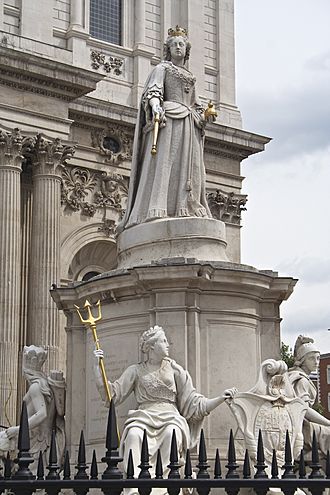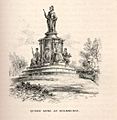Statue of Queen Anne, St Paul's Churchyard facts for kids
Quick facts for kids Statue of Queen Anne |
|
|---|---|

The statue in 2011
|
|
| Artist | Richard Claude Belt and Louis-Auguste Malempré, after Francis Bird |
| Year | 1886 |
| Medium | Marble |
| Subject | Anne, Queen of Great Britain |
| Location | London, United Kingdom |
| 51°30′49″N 0°06′00″W / 51.51368°N 0.09988°W | |
|
Listed Building – Grade II
|
|
| Official name | Statue of Queen Anne in forecourt of St Paul's Cathedral |
| Designated | 5 June 1972 |
| Reference no. | 1079158 |
A statue of Queen Anne stands in front of St Paul's Cathedral in London, United Kingdom. It is located in the open area outside the cathedral's main entrance. This important statue was recognized as a Grade II listed building in 1972. This means it is a historically important structure that needs to be protected.
Contents
The Story of the Queen Anne Statue
The statue you see today is a copy of an older one. The first statue was made in 1712 by Francis Bird from Carrara marble. It stood in the exact same spot. Queen Anne was the ruler of Britain when the new St Paul's Cathedral was finished in 1710.
Unveiling the Original Statue
Bird's first statue was shown to the public on July 7, 1713. This happened during a special service to celebrate the Peace of Utrecht. This peace treaty ended a major war in Europe. The original statue cost £1,130 to make. The Queen herself provided the marble.
Changes and Challenges for the First Statue
The first statue was surrounded by a beautiful metal fence. This fence was made by a skilled craftsman named Jean Tijou. Later, these elegant railings were removed. They were replaced with heavier ones that matched other fences around the cathedral.
Over the years, the original statue faced some problems. It was damaged at least three times. This happened in 1743, 1768, and 1882. Parts like the nose and arms were broken. By the 1880s, the statue was also very worn down by the weather.
Creating the New Statue
Because the old statue was so damaged, a new one was needed. Richard Claude Belt was asked to create a replacement in 1885. He used marble from Sicily for this new statue. The city of London paid £1,800 for it.
Another artist, Louis-Auguste Malempré, finished the sculpture. The company Mowlem and Sons did the building work to put the statue in place. Sir Horace Jones, the city architect, oversaw the project. The new statue was officially shown to the public on December 15, 1886. This was just one year before Queen Victoria's Golden Jubilee.
What the Statue Looks Like
The statue is made in the Baroque style. It shows Queen Anne standing tall. She faces down Ludgate Hill towards Ludgate Circus. The Queen is wearing a long robe. She also wears the special collar of the Order of the Garter. A shiny gold crown sits on her head. In one hand, she holds a gold orb. In her other hand, she holds a gold scepter.
The Pedestal and Its Figures
The Queen Anne figure stands on a stone base called a pedestal. This pedestal was designed by the famous architect Christopher Wren. It has four symbolic figures, one at each corner.
- To the west, facing Ludgate Hill, are two figures. One is Britannia, representing England, holding a gold trident. The other figure represents France. Between them is a carved image of the British Royal Coat of Arms.
- To the east, facing St Paul's Cathedral, are two more figures. One represents Ireland and holds a harp. The other represents North America. This figure looks like a Native American, wearing a feathered skirt and headdress. They hold a gold bow and a quiver of arrows.
The pedestal itself stands on three steps. Heavy cast iron railings surround these steps.
Inscriptions on the Pedestal
The pedestal has two important messages carved into its sides.
- On the south side, it says: "The Original STATUE / was erected on this spot in the year 1712 / to commemorate the completion of / SAINT PAUL'S CATHEDRAL / FRANCIS BIRD Sculptor." This tells us about the first statue and its purpose.
- On the north side, it says: "This Replica / of the Statue of QUEEN ANNE / was erected at the expense of / The CORPORATION of LONDON / In the year 1886 / The Rt. Hon. / SIR REGINALD HANSON M.A. F.S.A. / Lord Mayor / Wm. Braham Esq / Chairman of the City Lands Committee." This explains that the current statue is a copy. It also names the people who helped pay for and set it up.
The Original Statue's New Home
After the first statue was taken down, it was found abandoned. It was in the yard of a stonemason in London. The original 8-ton statue and its four 5-ton stone figures were bought by Augustus Hare. He moved them to his house, Holmhurst St Mary, near Hastings.
At Holmhurst St Mary, Queen Anne was placed on an oval base. The four other figures were arranged on steps around it, just like they were originally. In 1976, the house itself became a Grade II listed building. The statue received its own special Grade II* listing at the same time. This means it is a very important historical item.
Images for kids






